Abstract
Two rapid diagnostic tests for Chlamydia trachomatis (Microtrak, Syva Co., Palo Alto, Calif.; and Chlamydiazyme, Abbott Laboratories, North Chicago, Ill.) were evaluated in comparison with growth of the organism in tissue culture for 2,030 urogenital specimens from men and women. Neither test performed as well as culture, which detected 296 of 310 positive specimens. The overall sensitivity and specificity for Microtrak were 73 and 99%; corresponding values for Chlamydiazyme were 83 and 98%. The majority of false-negative results with both rapid tests occurred when cultures contained less than 10 inclusions per cover slip. There were also areas of unconfirmed reactivity for both tests that led us to suggest that a reporting category of "suspicious" be developed for certain test results. For Microtrak, the suspicious result is a slide containing fewer than 10 elementary bodies; for Chlamydiazyme, it is any absorbance reading less than 0.4. Creation of a "suspicious" category would lower the sensitivity for Chlamydiazyme considerably, to 64%, and increase the positive predictive value for females to 95%. Although this may result in the underreading of some specimens from males, the tests could then be used with greater confidence in females for whom testing is essential for appropriate treatment.
Full text
PDF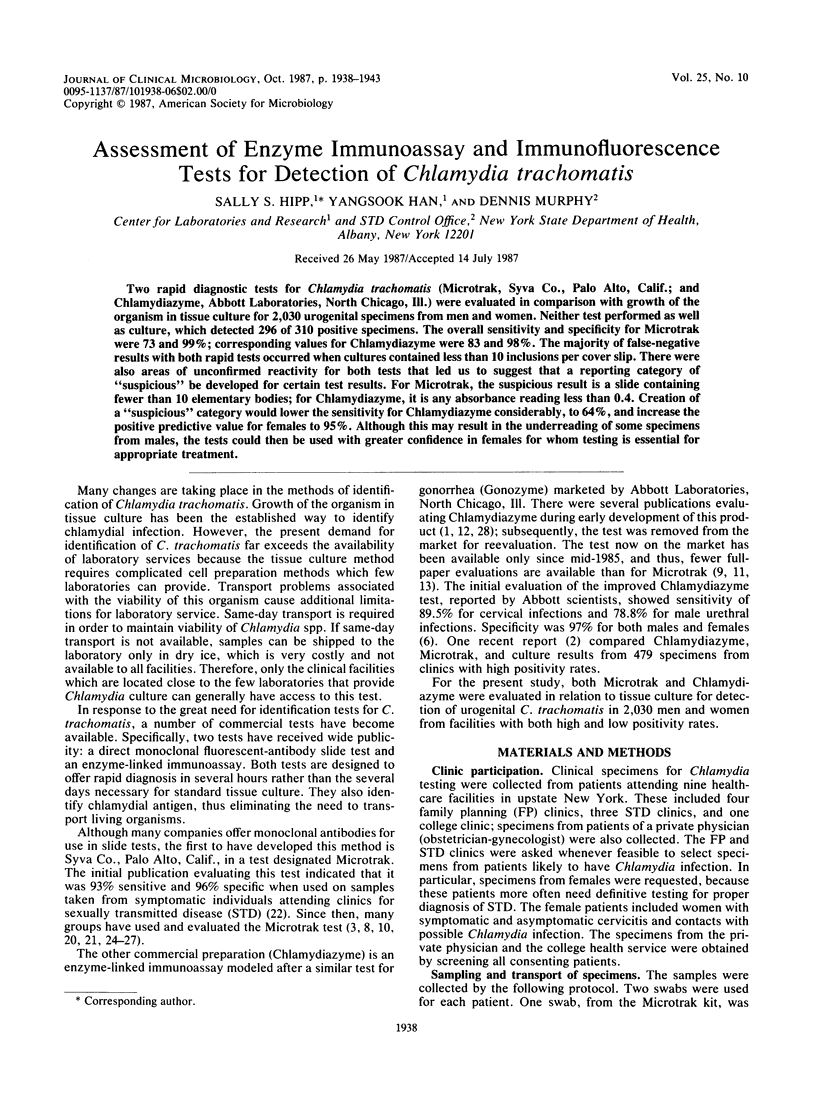
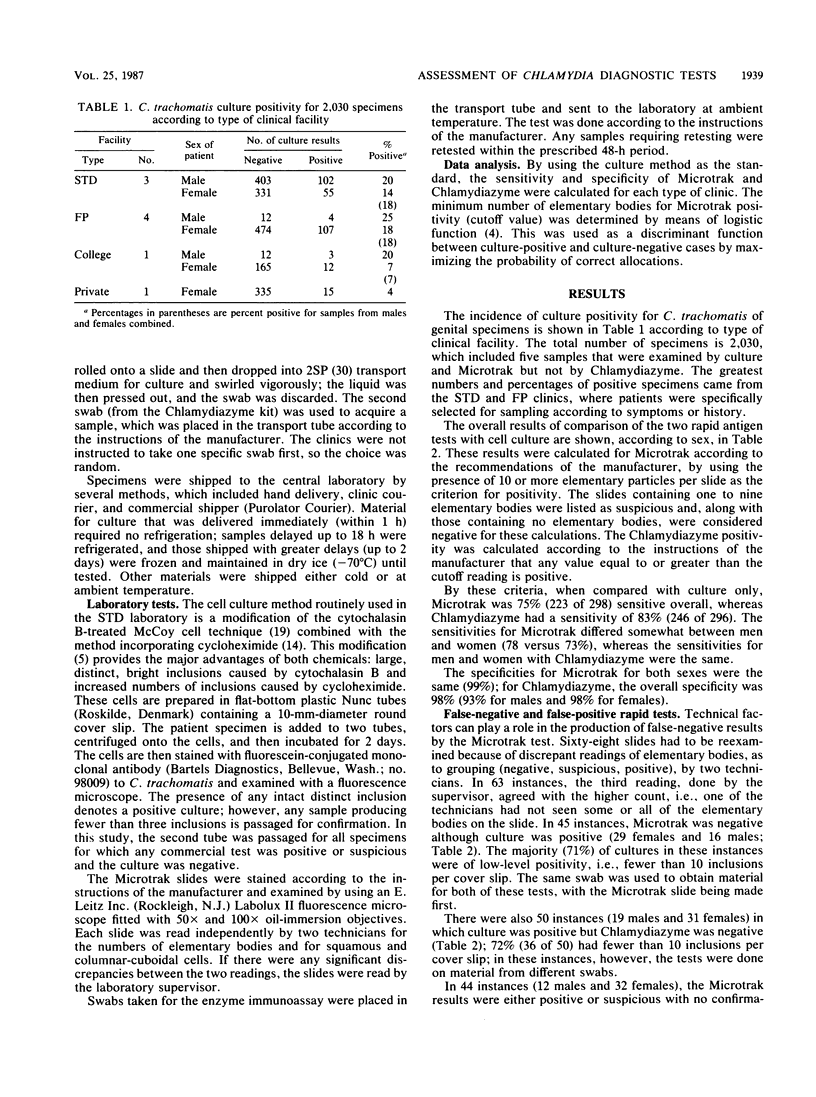
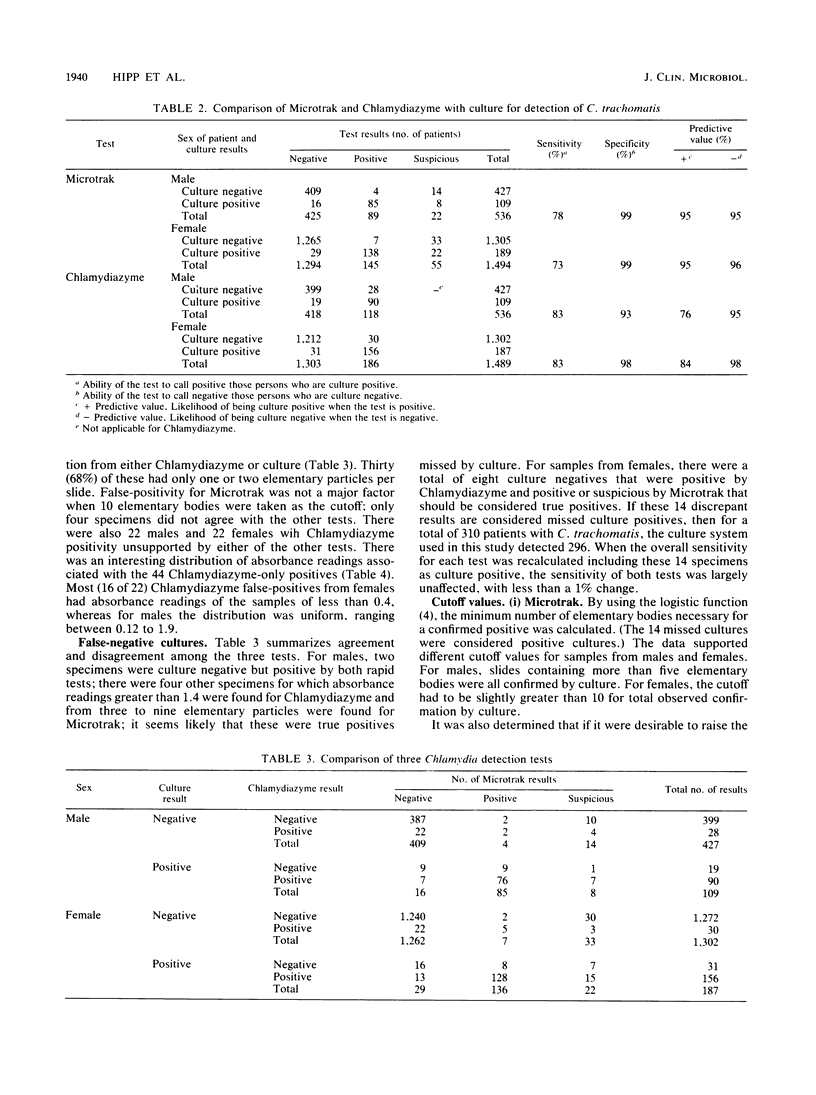
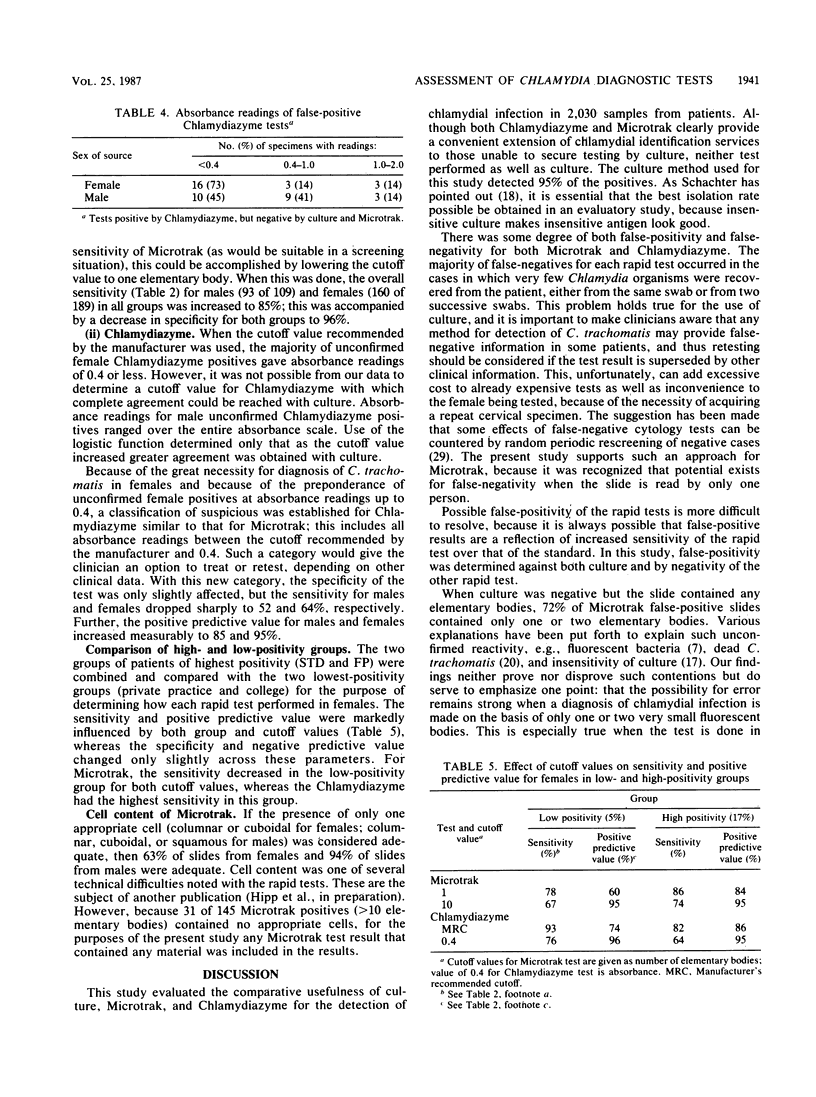

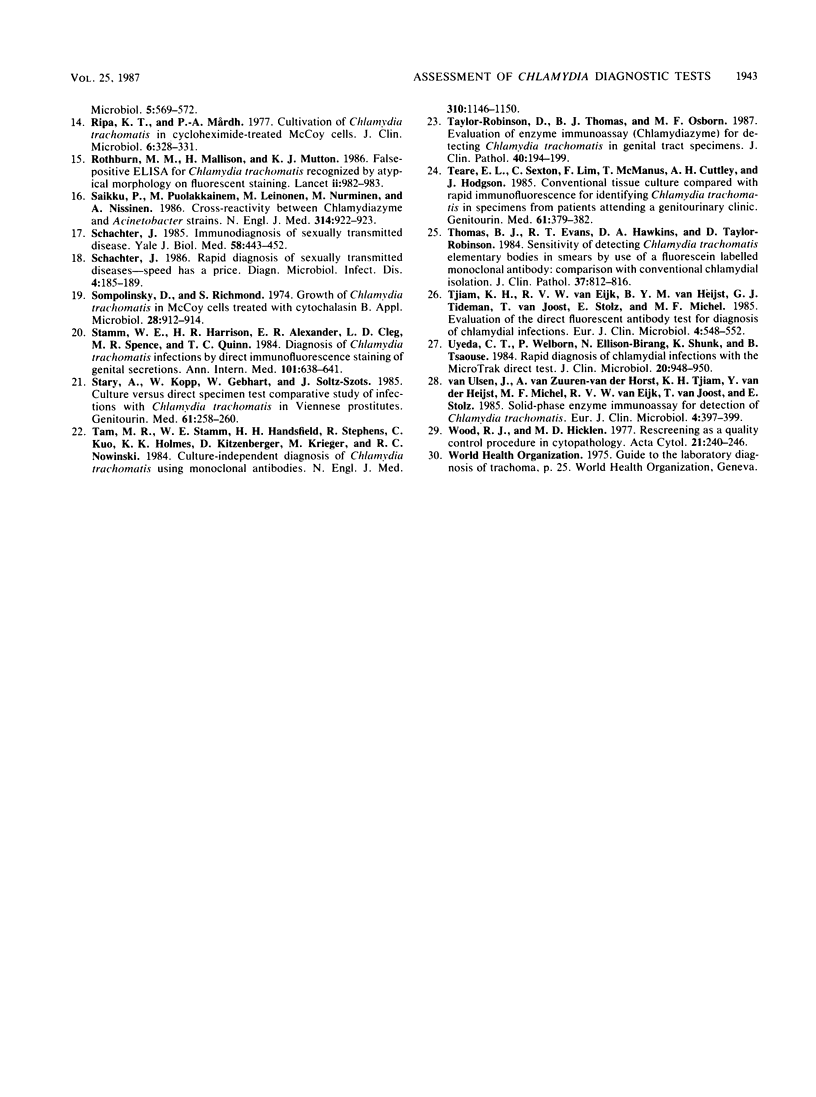
Selected References
These references are in PubMed. This may not be the complete list of references from this article.
- Amortegui A. J., Meyer M. P. Enzyme immunoassay for detection of Chlamydia trachomatis from the cervix. Obstet Gynecol. 1985 Apr;65(4):523–526. [PubMed] [Google Scholar]
- Chernesky M. A., Mahony J. B., Castriciano S., Mores M., Stewart I. O., Landis S. J., Seidelman W., Sargeant E. J., Leman C. Detection of Chlamydia trachomatis antigens by enzyme immunoassay and immunofluorescence in genital specimens from symptomatic and asymptomatic men and women. J Infect Dis. 1986 Jul;154(1):141–148. doi: 10.1093/infdis/154.1.141. [DOI] [PubMed] [Google Scholar]
- Coudron P. E., Fedorko D. P., Dawson M. S., Kaplowitz L. G., Brookman R. R., Dalton H. P., Davis B. A. Detection of Chlamydia trachomatis in genital specimens by the Microtrak direct specimen test. Am J Clin Pathol. 1986 Jan;85(1):89–92. doi: 10.1093/ajcp/85.1.89. [DOI] [PubMed] [Google Scholar]
- Howard L. V., Coleman P. F., England B. J., Herrmann J. E. Evaluation of chlamydiazyme for the detection of genital infections caused by Chlamydia trachomatis. J Clin Microbiol. 1986 Feb;23(2):329–332. doi: 10.1128/jcm.23.2.329-332.1986. [DOI] [PMC free article] [PubMed] [Google Scholar]
- Krech T., Gerhard-Fsadni D., Hofmann N., Miller S. M. Interference of Staphylococcus aureus in the detection of Chlamydia trachomatis by monoclonal antibodies. Lancet. 1985 May 18;1(8438):1161–1162. doi: 10.1016/s0140-6736(85)92467-5. [DOI] [PubMed] [Google Scholar]
- Larsen J. H., Wulf H. C., Friis-Møller A. Comparison of a fluorescent monoclonal antibody assay and a tissue culture assay for routine detection of infections caused by Chlamydia trachomatis. Eur J Clin Microbiol. 1986 Oct;5(5):554–558. doi: 10.1007/BF02017704. [DOI] [PubMed] [Google Scholar]
- Levy R. A., Warford A. L. Evaluation of the modified Chlamydiazyme immunoassay for the detection of chlamydial antigen. Am J Clin Pathol. 1986 Sep;86(3):330–335. doi: 10.1093/ajcp/86.3.330. [DOI] [PubMed] [Google Scholar]
- Lipkin E. S., Moncada J. V., Shafer M. A., Wilson T. E., Schachter J. Comparison of monoclonal antibody staining and culture in diagnosing cervical chlamydial infection. J Clin Microbiol. 1986 Jan;23(1):114–117. doi: 10.1128/jcm.23.1.114-117.1986. [DOI] [PMC free article] [PubMed] [Google Scholar]
- Moi H., Danielsson D. Diagnosis of genital Chlamydia trachomatis infection in males by cell culture and antigen detection test. Eur J Clin Microbiol. 1986 Oct;5(5):563–568. doi: 10.1007/BF02017706. [DOI] [PubMed] [Google Scholar]
- Mumtaz G., Mellars B. J., Ridgway G. L., Oriel J. D. Enzyme immunoassay for the detection of Chlamydia trachomatis antigen in urethral and endocervical swabs. J Clin Pathol. 1985 Jul;38(7):740–742. doi: 10.1136/jcp.38.7.740. [DOI] [PMC free article] [PubMed] [Google Scholar]
- Ripa K. T., Mårdh P. A. Cultivation of Chlamydia trachomatis in cycloheximide-treated mccoy cells. J Clin Microbiol. 1977 Oct;6(4):328–331. doi: 10.1128/jcm.6.4.328-331.1977. [DOI] [PMC free article] [PubMed] [Google Scholar]
- Rothburn M. M., Mallinson H., Mutton K. J. False-positive ELISA for Chlamydia trachomatis recognised by atypical morphology on fluorescent staining. Lancet. 1986 Oct 25;2(8513):982–983. doi: 10.1016/s0140-6736(86)90637-9. [DOI] [PubMed] [Google Scholar]
- Saikku P., Puolakkainen M., Leinonen M., Nurminen M., Nissinen A. Cross-reactivity between Chlamydiazyme and Acinetobacter strains. N Engl J Med. 1986 Apr 3;314(14):922–923. doi: 10.1056/NEJM198604033141413. [DOI] [PubMed] [Google Scholar]
- Schachter J. Immunodiagnosis of sexually transmitted disease. Yale J Biol Med. 1985 Sep-Oct;58(5):443–452. [PMC free article] [PubMed] [Google Scholar]
- Schachter J. Rapid diagnosis of sexually transmitted diseases--speed has a price. Diagn Microbiol Infect Dis. 1986 Mar;4(3):185–189. doi: 10.1016/0732-8893(86)90097-0. [DOI] [PubMed] [Google Scholar]
- Sompolinsky D., Richmond S. Growth of Chlamydia trachomatis in McCoy cells treated with cytochalasin B. Appl Microbiol. 1974 Dec;28(6):912–914. doi: 10.1128/am.28.6.912-914.1974. [DOI] [PMC free article] [PubMed] [Google Scholar]
- Stamm W. E., Harrison H. R., Alexander E. R., Cles L. D., Spence M. R., Quinn T. C. Diagnosis of Chlamydia trachomatis infections by direct immunofluorescence staining of genital secretions. A multicenter trial. Ann Intern Med. 1984 Nov;101(5):638–641. doi: 10.7326/0003-4819-101-5-638. [DOI] [PubMed] [Google Scholar]
- Stary A., Kopp W., Gebhart W., Söltz-Szöts J. Culture versus direct specimen test: comparative study of infections with Chlamydia trachomatis in Viennese prostitutes. Genitourin Med. 1985 Aug;61(4):258–260. doi: 10.1136/sti.61.4.258. [DOI] [PMC free article] [PubMed] [Google Scholar]
- Tam M. R., Stamm W. E., Handsfield H. H., Stephens R., Kuo C. C., Holmes K. K., Ditzenberger K., Krieger M., Nowinski R. C. Culture-independent diagnosis of Chlamydia trachomatis using monoclonal antibodies. N Engl J Med. 1984 May 3;310(18):1146–1150. doi: 10.1056/NEJM198405033101803. [DOI] [PubMed] [Google Scholar]
- Taylor-Robinson D., Thomas B. J., Osborn M. F. Evaluation of enzyme immunoassay (Chlamydiazyme) for detecting Chlamydia trachomatis in genital tract specimens. J Clin Pathol. 1987 Feb;40(2):194–199. doi: 10.1136/jcp.40.2.194. [DOI] [PMC free article] [PubMed] [Google Scholar]
- Teare E. L., Sexton C., Lim F., McManus T., Cuttley A. H., Hodgson J. Conventional tissue culture compared with rapid immunofluorescence for identifying Chlamydia trachomatis in specimens from patients attending a genitourinary clinic. Genitourin Med. 1985 Dec;61(6):379–382. doi: 10.1136/sti.61.6.379. [DOI] [PMC free article] [PubMed] [Google Scholar]
- Thomas B. J., Evans R. T., Hawkins D. A., Taylor-Robinson D. Sensitivity of detecting Chlamydia trachomatis elementary bodies in smears by use of a fluorescein labelled monoclonal antibody: comparison with conventional chlamydial isolation. J Clin Pathol. 1984 Jul;37(7):812–816. doi: 10.1136/jcp.37.7.812. [DOI] [PMC free article] [PubMed] [Google Scholar]
- Tjiam K. H., van Eijk R. V., van Heijst B. Y., Tideman G. J., van Joost T., Stolz E., Michel M. F. Evaluation of the direct fluorescent antibody test for diagnosis of chlamydial infections. Eur J Clin Microbiol. 1985 Dec;4(6):548–552. doi: 10.1007/BF02013392. [DOI] [PubMed] [Google Scholar]
- Uyeda C. T., Welborn P., Ellison-Birang N., Shunk K., Tsaouse B. Rapid diagnosis of chlamydial infections with the MicroTrak direct test. J Clin Microbiol. 1984 Nov;20(5):948–950. doi: 10.1128/jcm.20.5.948-950.1984. [DOI] [PMC free article] [PubMed] [Google Scholar]
- Wood R. J., Hicklin M. D. Rescreening as a quality control procedure in cytopathology. Acta Cytol. 1977 Mar-Apr;21(2):240–246. [PubMed] [Google Scholar]
- van Ulsen J., van Zuuren-van der Horst A., Tjiam K. H., van der Heijst Y., Michel M. F., van Eijk R. V., van Joost T., Stolz E. Solid-phase enzyme immunoassay for detection of Chlamydia trachomatis. Eur J Clin Microbiol. 1985 Aug;4(4):397–399. doi: 10.1007/BF02148691. [DOI] [PubMed] [Google Scholar]


